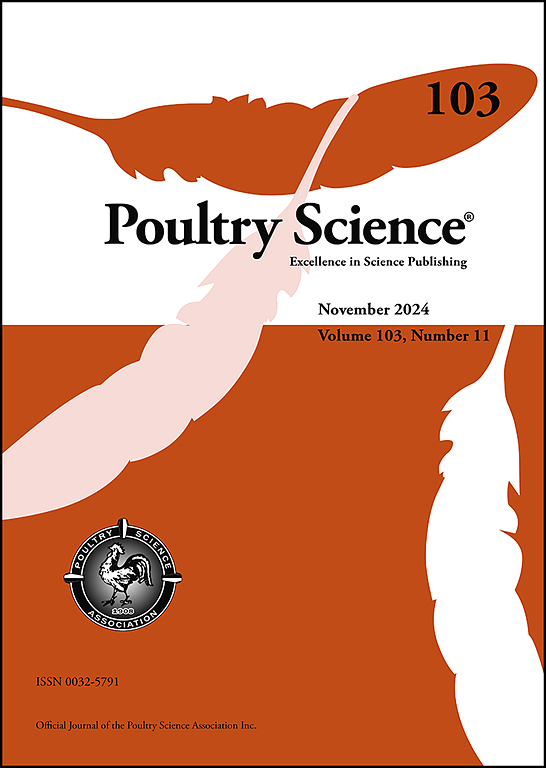土鸡本土品种与商业杂交种间变异和群体结构的全基因组比较分析
IF 3.8
1区 农林科学
Q1 AGRICULTURE, DAIRY & ANIMAL SCIENCE
引用次数: 0
摘要
新一代测序(NGS)技术使牲畜基因组学发生了革命性的变化,它能够利用数千个单核苷酸多态性(snp)对当地种群进行快速、高分辨率的基因分型,提供前所未有的准确性和成本效益。本研究首次采用双消化限制性位点相关DNA测序(ddRADseq)技术对德尼兹利(DNZ)和格泽(GRZ)鸡品种进行了全面的基因组评估,并将其与商品肉鸡和蛋鸡杂交品种进行了比较。DNZ和GRZ共有94,208个双等位基因snp,经过质量筛选,所有群体中保留了33,284个snp。土鸡品种的遗传多样性参数高于杂交种,其中DNZ和GRZ的次要等位基因频率(MAF)高于0.3,而商业杂交种的MAF值低于0.3。其中,DNZ的观察杂合度最高(0.386),预期杂合度最高(0.375),而肉鸡杂交种的杂合度最低(0.254),提示近交抑制(FIS = 0.241)。DNZ和GRZ鸡品种随机配种的近交系系数为负,而蛋鸡杂交种的近交系系数估计为0.118。主成分分析(PCA)、基于遗传距离的邻居连接(NJ)树、admix和TreeMix算法等群体结构分析表明,DNZ和GRZ在遗传上彼此不同,并且与商业杂交种也不同。本研究结果证实,综合保护策略是在不近交的情况下将遗传变异保持在最佳水平的有效途径。此外,本研究证明了ddRADseq在产生高通量基因型数据方面的有效性,为地方鸡品种的基因组多样性和群体结构研究提供了一个经济有效的框架。本文章由计算机程序翻译,如有差异,请以英文原文为准。
Genome-wide comparative analysis of variability and population structure between autochthonous Turkish chicken breeds and commercial hybrid lines
Next-generation sequencing (NGS) technologies have revolutionized livestock genomics by enabling rapid, high-resolution genotyping of local populations with thousands of single nucleotide polymorphisms (SNPs), offering unprecedented accuracy and cost efficiency. This study presents the first comprehensive genomic assessment of the Denizli (DNZ) and Gerze (GRZ) chicken breeds, comparing them to commercial broiler and layer hybrid lines using the double digest restriction-site associated DNA sequencing (ddRADseq) technique. A total of 94,208 bi-allelic SNPs were common between DNZ and GRZ, while 33,284 SNPs were retained among all populations after the quality filtering process. Genetic diversity parameters were higher in native Turkish chicken breeds compared to hybrid lines in which minor allele frequency (MAF) was higher than 0.3 in DNZ and GRZ while it was lower than this value in commercial hybrid lines. Notably, DNZ displayed the highest observed (0.386) and expected (0.375) heterozygosity, whereas the broiler hybrid line showed the lowest heterozygosity (0.254), suggesting inbreeding depression (FIS = 0.241). The negative inbreeding coefficient values occurring due to random mating were observed in DNZ and GRZ chicken breeds, while this value was estimated at 0.118 in the layer hybrid line. Population structure analyses such as principal component analyses (PCA), genetic distance-based neighbor-joining (NJ) tree, ADMIXTURE, and TreeMix algorithm revealed that DNZ and GRZ were genetically distinct from both each other and commercial hybrid lines. The results of this study confirm that comprehensive conservation strategies are efficient approaches to keeping genetic variability at an optimal level without inbreeding. Moreover, this study demonstrates the efficacy of ddRADseq in generating high-throughput genotypic data, providing a cost-effective framework for genomic diversity and population structure studies in indigenous chicken breeds.
求助全文
通过发布文献求助,成功后即可免费获取论文全文。
去求助
来源期刊

Poultry Science
农林科学-奶制品与动物科学
CiteScore
7.60
自引率
15.90%
发文量
0
审稿时长
94 days
期刊介绍:
First self-published in 1921, Poultry Science is an internationally renowned monthly journal, known as the authoritative source for a broad range of poultry information and high-caliber research. The journal plays a pivotal role in the dissemination of preeminent poultry-related knowledge across all disciplines. As of January 2020, Poultry Science will become an Open Access journal with no subscription charges, meaning authors who publish here can make their research immediately, permanently, and freely accessible worldwide while retaining copyright to their work. Papers submitted for publication after October 1, 2019 will be published as Open Access papers.
An international journal, Poultry Science publishes original papers, research notes, symposium papers, and reviews of basic science as applied to poultry. This authoritative source of poultry information is consistently ranked by ISI Impact Factor as one of the top 10 agriculture, dairy and animal science journals to deliver high-caliber research. Currently it is the highest-ranked (by Impact Factor and Eigenfactor) journal dedicated to publishing poultry research. Subject areas include breeding, genetics, education, production, management, environment, health, behavior, welfare, immunology, molecular biology, metabolism, nutrition, physiology, reproduction, processing, and products.
 求助内容:
求助内容: 应助结果提醒方式:
应助结果提醒方式:


